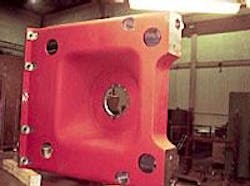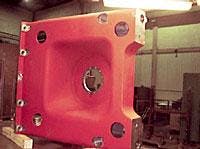Cast steel technique brings benefits to Nigerian seabed components
Paul Eastaugh
Contributing Editor
Cast steel components were found to offer the best solution in the manufacture of pipeline support porches in a project for the Nigerian Corrib field. Kohlswa Gjuteri has just completed an order for ABB Offshore Services to manufacture 25 units that will be used to carry power and communi-cations conduits to a seabed separation plant to be installed in 900 m of water offshore Nigeria. The castings measure 1.36 by 1.20 m and include a funnel design that facilitates insertion of the pipe by ROV. The castings each weigh 1.1 tons and have been designed so that each can accommodate variations in the slope of the seabed.
The decision to use cast components arose after cracks were discovered in earlier welded plate versions. The design of the porches suggested welding as the most obvious manufacturing method, and the Kohlswa foundry engineers were initially surprised by the interest ABB's designers showed in the company's services. However, detailed discussions and liaison over six months revealed numerous advantages of casting compared with making the same product by welding.
The principal requirement for the components is structural strength. The weld failures on the original version were a major shortcoming and demonstrated that higher forces were present than had been initially anticipated, and these demanded an alternative solution. Because of the water depth, corrosion is not a problem. This eliminated the need for stainless steel and opened the door to the use of cast A216 WC carbon steel.
Varying wall thickness
As design development progressed, additional benefits from using cast steel became apparent. Among these was the possibility to vary the wall thickness of different parts of the porch to accommodate the local stresses likely to be encountered. Wall thicknesses consequently ranged from 26 mm to 60 mm, and these made it possible to save weight in areas where strength was not an imperative. In parts where the stresses were likely to be more severe, Kohlswa Foundry designers were able to increase the metal thickness accordingly. This freedom was unavailable to welding fabricators who would be required to specify steel plate in a uniform thickness that would have to be adequate for the most stressed part of the component.
Easy ROV access
Steel casting also made it easier to form the dished shape that serves as the pipe guide used by the ROV pilot when directing the pipe through the hole. Two small funnels were also required, but these were welded onto the casting to simplify manufacture. A similar construction using plate steel throughout would have proved difficult and expensive to make. Unlike the welded construction that is stronger laterally but weaker near the joint, the cast bracket has a uniform strength in every direction.
Low corrosion
The natural ease with which the casting process creates rounded surfaces is also expected to benefit the overall life expectancy of the components. Although the support porches were painted to provide some measure of protection, their rounded shape is known to reduce the incidence of corrosion that can often be initiated by damage to sharp corners or by abrasion caused through water turbulence.
Manufacture at Kohlswa Foundry was complex, as it involved the use of a two-part mold. This made it possible to alter the base angle of the bracket by using a different mold part that had been manufactured to accommodate the differing seabed angles along the length of the pipeline.
The team at Kohlswa Gjuteri made extensive use of 3D computer simulation throughout the design process. A special program, known as Nova Solid, predicted the mold pouring requirements and the solidification process of the cast metal. This program was run for every change in the design and was considered essential to the operation, as it overcame the need to create pin holes during the manufacturing process. This facility, when used in conjunction with wooden mold patterns, also makes it possible for design changes to be introduced on later versions of the support porches if, for example, it is decided that additional stiffeners or other structural details are necessary.
Historic pedigree
Kohlswa Gjuteri, founded as far back as 1548, has developed special products for different sectors of the engineering industry that can now be manufactured on request in structural steel as well as in quenched and tempered high strength steels. Marine industry products manufactured by the company in recent years include keels, propeller blades, and hub bodies, often in stainless martensitic or duplex steels to provide corrosion resistance. Shackles and other accessories for oil rig anchoring systems have also been produced that can meet exacting demands for tensile strength and impact resistance.
For more information, contact Hakan Thoreson, Kohlswa Gjuteri. Tel: +46 221 830 00, fax: +46 221 83019, email: [email protected].
null

